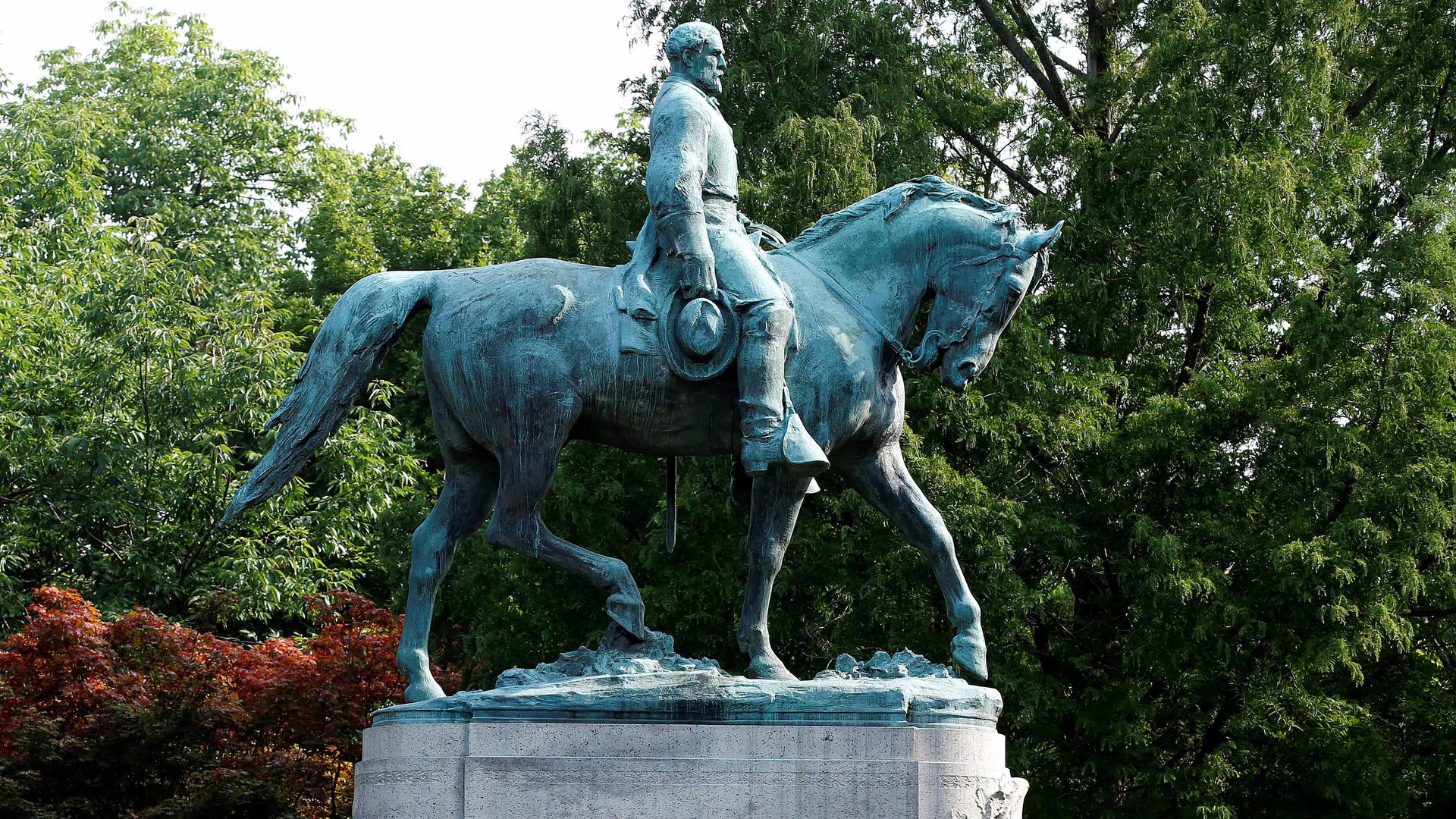This is a Robert E. Lee statue in Charlottesville, Virginia.
Donald Trump is not known for his strong grasp of history. But in controversial unscripted remarks this week, Trump claimed "leftists" were trying to rewrite history by destroying monuments.
“This week it's Robert E. Lee. I notice that Stonewall Jackson is coming down,” he said on Tuesday, referring to the top two generals of the Confederacy in the Civil War. “I wonder,” he continued, “is it George Washington next week? And is it Thomas Jefferson the week after. You really do have to ask yourself, where does it stop?"
The president was speaking off-the-cuff in response to reporters’ questions about the racially charged violence in Charlottesville, Virginia, on Saturday.
He doubled down on that sentiment on Thursday with a series of tweets, saying “the history and culture of our great country” are being “ripped apart with the removal of our beautiful statues and monuments.”
His sentiment has strong echoes in the rhetoric of white supremacist groups, and even some more moderate conservative groups, about the need to defend “heritage” against what they see as an attempt to erase or rewrite history. It fits those groups' narrative about the demographic and cultural displacement of “white” Americans.
Calls for the demolition of Confederate cemeteries and memorials to their war dead, and criticisms of Thomas Jefferson and other prominent slave owners from the early days of the republic, have created unease among some whites, an unease that white supremacist, neo-Nazi and white nationalist groups appear to be attempting to exploit as a galvanizing issue to win funding and recruits.
A CBS poll released Thursday says 67 percent of Republicans approve of the president’s response to Charlottesville.
On the other side of the issue, an effort is underway in towns and cities across the South to remove statues and monuments commemorating Confederate leaders and soldiers. The argument is that these are symbols of white supremacy erected in the era of Jim Crow and segregation, from the 1890s into the 1950s.
So how is a nation supposed to memorialize a divided and controversial history? Well, America is not alone in this and plenty of models exist.
One person who has given this issue a lot of thought is Laurent Dubois, professor of history at Duke University in Durham, North Carolina. On Wednesday, he tweeted out this thought:
Dubois went on to suggest Americans leave the empty pedestals there and develop historical panels explaining their history as monuments. Alongside them, he suggests, Americans could place panels with photographs recounting how and why they came down.
In that way, he says, “you’d actually get a sense of the dynamism of history, and the fact that monuments are about public declaration of values.”
He cites as an example, a statue in the Caribbean island of Martinique of Empress Josephine, wife and lover of Napoleon Bonaparte. She was also a member of a family that grew wealthy on the backs of slaves working sugar plantations in the French colony. Napoleon ordered a brutal campaign to reconquer the island and reintroduce slavery. He and his local wife were therefore celebrated by the white ruling elite there.
In the 1980s, independence activists decapitated the statue and painted it with blood, as though it had been guillotined. Rather than replace the head, the local community decided to leave it as it was, as a way to reinterpret history.
“In the middle of the town square,” Dubois says, “you have a monument that’s been transformed by activists, and that Martiniquans now see as their monument, as they’ve reclaimed it in a certain way.”
Related: Three ways the Trump administration has downplayed white supremacy
“A monument always has to do with three different historical moments,” he says. “It’s a reference to a particular moment in the past. It’s also a representation of the moment when it was built … and then we in the present have to think about these monuments and what they mean today, and whether they fit with our values as a society.”
“It’s also the case,” Dubois adds, “that we need to cultivate and expand a broader historical memory. So the history of slavery itself — the history of abolitionists, the history of how slavery was destroyed, the history of the enslaved people who fought against slavery — all those are things that could be much better known and much more present in our public spaces.”
“One solution is to think about that … both the removal of some monuments, but also what kinds of public art, what kinds of public recognition of history do we want to foreground?” he says. “And there are lots and lots of Americans that have fought for justice and equality, who fought against slavery, who could be acknowledged and could be celebrated.”
Dubois is less comfortable with calls for removing grave markers and memorials to the Confederate war dead. “Graves are generally considered a really different situation, obviously, just because of the sacredness that people have around graveyards,” he says. “But of course monuments to the dead are kind of in-between.”
He points out that there are monuments to the dead in Germany from World War II, despite that nation’s absolute repudiation of Nazism and Nazi symbols. “Those kinds of questions are really, really complicated,” he says.
